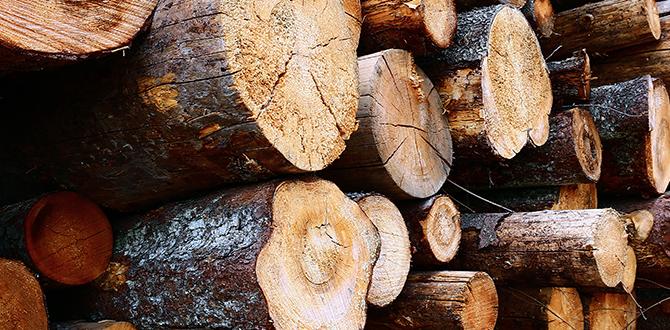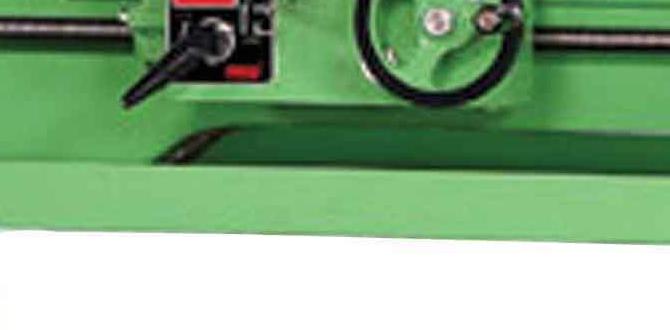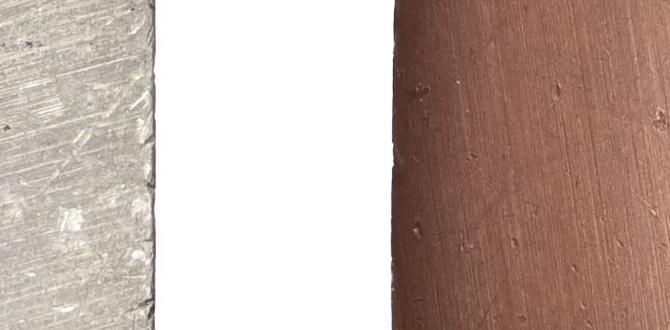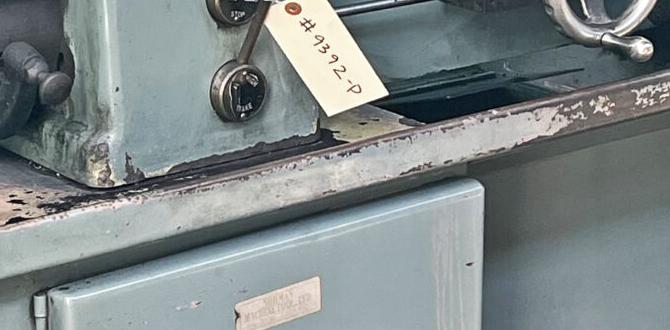Quick Summary: Absolutely! A buffing wheel for your lathe is a proven essential tool for achieving a superior finish onturned projects. It uses gentle abrasion to smooth surfaces, remove minor imperfections, and leave your creations looking polished and professional. This guide shows you why and how to use one effectively.
Hey there, aspiring makers! Daniel Bates here from Lathe Hub. Ever finished a project on your lathe, only to feel like it’s just… missing something? That smooth, showroom finish that makes you say “Wow!”? You’re not alone. Getting that perfect shine can be a real head-scratcher for newcomers. But what if I told you there’s a simple, powerful tool designed to do just that? The buffing wheel for your lathe is one of those unsung heroes. It’s not complicated, but it can transform your work. Today, we’ll dive into why this tool is an absolute must-have and walk through exactly how to use it safely and effectively. Let’s get polishing!
Why the Buffing Wheel is Your Lathe’s Best Friend
Think of your lathe as the sculptor, shaping your materials into beautiful forms. Now, imagine a specialized artist’s brush that comes in at the end to add the final, exquisite details. That’s essentially what a buffing wheel does for your turned items. It takes your project from “nicely made” to “absolutely stunning” with minimal effort.
For beginners, the temptation is to rely solely on sanding. Sanding is crucial, no doubt about it. But even the finest grit sandpaper can leave microscopic scratches. These might not be visible to the naked eye, but they prevent that deep, lustrous finish. This is where the buffing wheel shines. It uses gentle abrasion with polishing compounds to remove those last traces of imperfection and bring out the material’s natural beauty.
Using a buffing wheel isn’t just about aesthetics; it’s a practical step that enhances the longevity and appeal of your work. Whether you’re turning pens, bowls, or intricate spindles, the buffing wheel is your secret weapon for professional-quality results, every single time.
Understanding Buffing Wheels: What Are They and How Do They Work?
At its core, a buffing wheel is a disc, typically made of soft material like cloth, felt, or leather, that attaches to your lathe. It spins with the lathe, and you apply a polishing compound to its surface. As the wheel spins, it transfers this compound to your workpiece and gently abrades away the finest imperfections, leaving a smooth, clean surface.
The magic happens through friction and the abrasive action of the polishing compound. The wheel material itself is usually soft enough not to cause damage, but firm enough to hold the compound and create the necessary friction. Different wheel materials are suited for different tasks and compounds, which we’ll explore next.
Types of Buffing Wheels
Not all buffing wheels are created equal. The material they’re made from plays a big role in what they can achieve. For beginners, understanding these differences will help you choose the right wheel for your project:
- Cotton Buffing Wheels: These are perhaps the most common and versatile. Made from layers of cotton fabric sewn together, they are excellent for general-purpose polishing and applying a wide range of compounds. They tend to be softer and conform well to the shape of your workpiece.
- Flannel Buffing Wheels: Similar to cotton but often softer and more pliable, flannel wheels provide an even gentler polishing action. They are ideal for achieving a very high gloss finish on softer materials like woods and plastics.
- Sisal Buffing Wheels: These are made from woven sisal fibers, giving them a much stiffer and more aggressive cutting action than cotton or flannel. Sisal wheels are usually used with coarser polishing compounds for initial cutting and removing minor scratches before moving to softer wheels for finishing. Safety warning: due to their stiffness, always wear eye protection and ensure a secure mounting.
- Leather Buffing Wheels: Leather wheels, often combined with specialized compounds, are fantastic for achieving a mirror-like finish, particularly on metals. They offer a firm surface that holds its shape well.
- Felt Buffing Wheels: Made from compressed wool felt, these wheels offer a good balance between firmness and flexibility. They are great for general polishing and can be used for both cutting and finishing, depending on the compound used.
Polishing Compounds: The “Polish” in Buffing Polish
The buffing wheel is the applicator, but the polishing compound is the active ingredient. Think of compounds as very fine abrasives suspended in a waxy or greasy base. They come in different grades, from coarse to super-fine:
- Cutting Compounds: These have larger abrasive particles and are used for removing significant scratches or shaping material. They are typically used with stiffer wheels like sisal.
- General Purpose Compounds: These are your workhorses, suitable for a wide range of materials and for taking things from a decent finish to a good one. Often used with cotton or felt wheels.
- Finishing Compounds: These have very fine abrasives designed to bring out a high gloss and a mirror-like shine. They are usually applied with soft cotton or flannel wheels.
- Specialty Compounds: You can find compounds formulated for specific materials, like aluminum polish, brass polish, or even specific wood finishes.
A common beginner setup might involve a general-purpose compound and a finishing compound, used in sequence. You’d start with the general compound on a less dense wheel and then switch to a finishing compound on a softer wheel.
Essential Tools and Materials for Buffing
Before you get started, gather everything you need. Having all your supplies ready ensures a smooth and safe buffing session. Here’s a checklist:
- Your Lathe: Obviously! Make sure it’s clean and in good working order.
- Buffing Wheel(s): Choose based on your project material and desired finish (cotton, flannel, felt are great for beginners).
- Buffing Compound(s): Start with a general-purpose compound and a finishing compound.
- Buffing Arbor or Spindle Adapter: This crucial piece allows you to securely mount the buffing wheel onto your lathe’s spindle. It typically has a threaded end that matches your lathe’s spindle thread.
- Safety Glasses or Face Shield: Absolutely non-negotiable. Buffing can send small particles flying.
- Dust Mask or Respirator: Especially important when working with certain compounds or materials.
- Shop Apron or Old Clothes: Compounds can be messy and stain fabric.
- Tack Rag or Microfiber Cloths: For applying compound and wiping away excess.
- Workpiece: Your turned project, sanded to at least 400-grit (or finer, depending on your goal).
- Optional: Vacuum System: If your lathe has dust collection, it’s a bonus.
For a comprehensive guide on lathe safety, including eye protection, you can refer to resources like the OSHA standard on machine guarding, which emphasizes the importance of protecting yourself from moving machinery hazards.
Step-by-Step Guide: How to Use a Buffing Wheel on Your Lathe
Now, let’s get to the good part! Follow these steps carefully for a flawless finish. Remember, safety first!
Step 1: Prepare Your Lathe and Workspace
- Turn off and unplug your lathe: Always ensure the machine is completely powered down before making any adjustments or attachments.
- Clean your lathe: Remove any dust, shavings, or debris from the lathe bed, tailstock, and headstock area. A clean workspace is a safer workspace.
- Install the Buffing Arbor: Screw your buffing arbor onto the lathe’s headstock spindle. Hand-tighten it firmly. Ensure it’s the correct thread size for your lathe.
- Mount the Buffing Wheel: Slide your chosen buffing wheel onto the arbor. Secure it according to the arbor’s instructions, usually with a washer and nut. Make sure it’s on straight and tight.
- Set Up Safety Gear: Put on your safety glasses or face shield. If you have a dust mask or respirator, wear it now.
Step 2: Prepare Your Workpiece
Your workpiece needs to be as smooth as possible before buffing. If you’re new to this, aim for a surface sanded to at least 400-grit. For very fine finishes, sanding up to 1000 or 2000-grit is sometimes done, but 400-grit is a good starting point for most beginners. Ensure all sanding dust is wiped away.
Step 3: Apply the Polishing Compound
This is where gentle application makes a difference.
- Turn the lathe OFF.
- Hold the compound to the wheel: Gently press the buffing compound against the spinning wheel. You don’t need to push hard. Just enough to transfer a small amount of compound to the wheel’s surface. A little goes a long way.
- Spread the compound: Let the wheel spin and spread the compound evenly across its surface for a few seconds. Most wheels will turn in a specific direction to load the compound properly.
Important Note: Never apply compound to a stationary wheel; you’ll just create a mess and potentially damage the wheel. Always apply to a spinning wheel, and always turn the lathe OFF before applying compound. Reapply as needed, but avoid overloading the wheel.
Step 4: Buff Your Workpiece
This is where the magic happens!
- Turn the lathe ON: Set your lathe to a relatively slow speed. For buffing, slower is often safer and more effective, especially when starting. A speed between 800-1500 RPM is usually a good range, but consult your lathe’s manual.
- Hold the workpiece to the wheel: Gently bring your workpiece into contact with the spinning, compound-loaded buffing wheel.
- Move the workpiece: Keep the workpiece moving across the entire surface of the buffing wheel. Do not hold it in one spot; this can create flat spots or burn patterns. Work from one end of your project to the other, ensuring even coverage. Use light, consistent pressure.
- Work in sections: For larger pieces, work on one section at a time, then move to the next.
- Inspect your work: Periodically stop the lathe and inspect your progress. Look for an even sheen.
Safety Tip: If you feel resistance or the lathe slows down significantly, you’re pressing too hard. Ease up immediately.
Step 5: Second Stage Buffing (Optional but Recommended)
Once you’ve achieved a good finish with your general-purpose compound, you can move to a finer finishing compound for that extra sparkle.
- Clean the workpiece: Wipe off any residue from the first compound.
- Prepare a second wheel (or clean the first): Ideally, use a separate, clean, softer wheel (like flannel) for your finishing compound. If you only have one wheel, you might need to clean it thoroughly to remove all traces of the previous compound.
- Apply finishing compound: Load your finishing compound onto the clean wheel, just as you did before.
- Buff again: Repeat Step 4 with the finishing compound and the clean, soft wheel. Use even lighter pressure and ensure you cover the entire surface to achieve a brilliant shine.
Step 6: Final Cleaning and Inspection
- Turn off the lathe: Power down the machine.
- Remove the workpiece: Carefully take your polished piece off the lathe.
- Wipe Clean: Use a clean tack rag or microfiber cloth to wipe away any remaining compound residue.
- Inspect: Admire your work! You should see a smooth, consistent shine with minimal visible scratches.
This process, refined over years of metalworking and woodworking, ensures you get the best results. Organizations like the American Association of Woodturners (AAW) often share tips and techniques for achieving excellent finishes, and buffing is a cornerstone of their advice.
Buffing Wheels vs. Sanding: What’s the Difference?
It’s a common question for anyone new to finishing: why bother with a buffing wheel when I’ve already sanded my piece so smooth?
Think of it like this:
| Feature | Sanding | Buffing Wheel |
|---|---|---|
| Primary Action | Removes material to smooth and shape. | Polishes and refines an already smooth surface. |
| Abrasive Type | Exposed grit on paper (e.g., aluminum oxide, silicon carbide). | Very fine abrasives held in a compound, applied to a soft wheel. |
| Effectiveness for Finish | Establishes a smooth base. Can leave microscopic scratches. | Removes microscopic scratches left by sanding, creates high gloss. |
| Aggressiveness | Varies greatly by grit. Can remove significant material. | Generally low aggression, focused on surface refinement. |
| Use Case | Initial shaping, moderate smoothing. Higher grits for finer surfaces. | Final finishing, achieving a deep shine, removing swirl marks. |
Sanding is about creating the fundamental smooth surface. Buffing is about taking that smoothness to the absolute highest level. You can’t get a truly brilliant, deep shine without both steps, especially on materials that take a polish well, like certain woods or metals.
Tips for Achieving the Best Buffing Results
Even with a step-by-step guide, a few extra tips can make your buffing experience even better.
- Start Slow: Always begin buffing at a lower lathe speed and gradually increase if needed. High speeds can generate heat, which can damage your workpiece or compound.
- Cleanliness is Key: Keep your buffing wheels clean. As compounds build up, they can become less effective or even transfer incorrect compounds. A stiff brush can help clean wheels, or dedicated wheel maintenance tools exist.
- Dedicated Wheels for Projects: If you’re working with different materials (e.g., wood and metal), consider having separate buffing wheels for each to avoid cross-contamination of compounds and debris.
- Don’t Over-Compound: Too much compound can create a gummy mess and reduce the effectiveness of the abrasives.
- Maintain Consistent Pressure: Apply light, even pressure. Uneven pressure leads to an uneven finish.
- Work the Entire Surface: Always keep the workpiece moving across the face of the buffing wheel to ensure a uniform finish.
- Practice Makes Perfect: Don’t be discouraged if your first attempts aren’t flawless. The more you practice, the better you’ll become at judging pressure, speed, and compound application.
- Consider Different Compounds: As you progress, experiment with different types of polishing compounds. Some are specifically designed for certain materials and can yield exceptional results. For instance, advancements in finishing technologies can be explored through resources like the Society of Manufacturing Engineers (SME), which often discusses cutting-edge finishing processes.
Troubleshooting Common Buffing Problems
Even with the best intentions, you might run into a few bumps. Here’s how to handle them:
- Swirl Marks: These are circular scratches left by the buffing wheel. Usually caused by too much pressure, a wheel that’s too soft for the compound, or inconsistent movement. Solution: Reduce pressure, use a firmer wheel if appropriate, and ensure consistent, sweeping motions.
- Burn Marks/Heat Buildup: If your workpiece feels hot, or you see discoloration, you’re using too much pressure or speed, or holding the piece in one spot for too long. Solution: Reduce speed and pressure, keep the piece moving constantly.
- Dull Finish Instead of Shine: This can happen if your workpiece wasn’t sanded smoothly enough beforehand, if you’re using the wrong compound for the material, or if your finishing wheel is contaminated. Solution: Ensure your sanding is progressive and fine enough. Use a dedicated finishing compound with a soft, clean wheel.
- Compound Not Sticking to Wheel: The wheel might be too waxy or glazed. Solution: Clean the wheel or try a different type of compound.
Buffing Wheel Maintenance
Keeping your buffing wheels in good condition will extend their life and improve your results.
- Cleaning: After use, clean your buffing wheels to remove excess compound and material debris. A stiff brush designed for buffing wheels is useful here. For cotton wheels, sometimes a quick spin at high speed can fling off a




